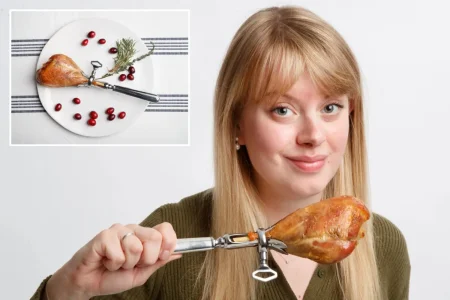How GLP-1 Drugs Are Transforming Thanksgiving Traditions
Jennifer Stojkovic is eagerly anticipating this Thanksgiving for a unique reason. As a new mother who gave birth to her son Roman in September, she’s embracing the holiday as an opportunity to indulge in much-needed calories for recovery and breastfeeding. Her heart is set on a decadent sweet potato casserole loaded with brown sugar, dried cranberries, streusel topping, and mini marshmallows. However, Stojkovic faces an unexpected challenge: several family members are now taking GLP-1 diabetes and weight-loss medications like Ozempic, Mounjaro, and Zepbound. These drugs have drastically reduced their appetites and changed their taste preferences, leading to what Stojkovic describes as a “streamlined menu” with fewer appetizers and sweets, and more protein-focused dishes instead of traditional carb-heavy fare. “I think a lot of people are using less sugar in things,” she notes, insisting she’ll ensure those marshmallows make it onto her casserole despite the changing dietary landscape.
This scenario is playing out across America as GLP-1 medications become increasingly popular, particularly among women aged 50 to 64 – often the very people who traditionally orchestrate family Thanksgiving celebrations. Erin Cadden, a Pennsylvania grandmother who has lost 40 pounds on a compounded GLP-1 drug since 2023, exemplifies this quiet revolution. She’s been secretly substituting Stevia for sugar in her legendary sweet potato casserole, inspired by Ruth’s Chris Steak House. “I didn’t tell them, because you know what? That was just my choice to switch sugars, for me,” Cadden explains, noting that nobody has detected the difference. Beyond ingredient substitutions, she’s also reducing her dessert offerings this year, replacing her traditional chocolate peanut butter pie with fresh fruit to avoid “an abundance of desserts.” The medication has changed not just what she can eat, but what she wants to prepare for her loved ones.
The transformation is even more dramatic in rural Alabama, where Andrea Lusk’s Thanksgiving spread will be missing numerous traditional dishes including pecan pie, sweet potato pie, ham, baked macaroni and cheese, onion-topped green bean casserole, and her famous Kentucky wonder beans. Since starting semaglutide (the active ingredient in Ozempic and Wegovy) in August, Lusk has lost 15 pounds, and her husband has joined her on the GLP-1 journey. Their meals have become healthier and their portions smaller. “The food noise, to where my eyes are bigger than my stomach, that has ceased,” Lusk shares. “And when I eat so much, I can’t eat anymore, period.” Instead of hosting a traditional feast that would typically lead to a 3-5 pound weight gain, Lusk and her husband plan to enjoy baked chicken at Golden Corral. For friends and neighbors who visit, she’ll offer lighter options like banana nut bread with mustard and “skinny” ambrosia salad – orange sections and Maraschino cherries without the sugary juice.
The intergenerational dynamics created by these medications can sometimes be uncomfortable, as 19-year-old college student Chloe Krznar has discovered. Her diabetic grandmother, a professional baker for over 30 years, has lost nearly 70 pounds since starting Ozempic more than a year ago. While Krznar is proud of her grandmother’s transformation, dining together has created an awkward dynamic: “I’ve gotten used to it, but definitely it is awkward at times,” she admits. “Especially for big family functions like Thanksgiving, it does get awkward, and sometimes it makes you feel guilty about yourself.” With 15-20 family members gathering for Thanksgiving in Pennsylvania – including her grandmother and several cousins on GLP-1 medications – Krznar expects the drugs to be a topic of conversation. Her grandmother has not only reduced her portion sizes but embraced a whole-food diet, likely introducing new dishes like rice and beans to the traditional spread. When asked if she’ll partake in these healthier alternatives, Krznar confesses, “No, probably not,” revealing the tension between evolving and traditional holiday food preferences.
For those on GLP-1 medications who aren’t hosting Thanksgiving, medical experts recommend planning ahead rather than abandoning treatment. Dr. Sue Decotiis, a triple-board certified medical weight-loss physician in Manhattan, suggests reviewing the menu beforehand and bringing dishes that accommodate their needs. “Maybe you’ll just bring some oven-roasted yams instead of the candied yams… or turnip can be very good with just some cinnamon on it,” she recommends. “It’s kind of nice that you can control what you’re having, and others can enjoy that as well.” Turkey, salad, and vegetables like Brussels sprouts are ideal choices, while foods with a high glycemic index – such as white rice, pasta without protein, white potatoes, commercial stuffing, and sugary yams – should be approached with caution. Drinking plenty of water is also advised.
While some GLP-1 users might be tempted to skip their medication for the holiday to fully indulge in traditional feasting, Dr. Decotiis strongly cautions against this practice. Patients who take this approach often gain 15-20 pounds rapidly, then face the difficult process of reintroducing the expensive medication and scaling up the dosage after the New Year. “We don’t want to have to do that,” Dr. Decotiis warns. “It’s not that hard a holiday to navigate.” As these medications continue to reshape America’s relationship with food, Thanksgiving – the ultimate celebration of abundance – is becoming a testing ground for how families negotiate between traditional indulgence and newly emerging health priorities. For some, it’s about subtle substitutions; for others, it’s a complete menu overhaul; but for everyone involved, the holiday feast is evolving in response to this pharmaceutical revolution in weight management.















